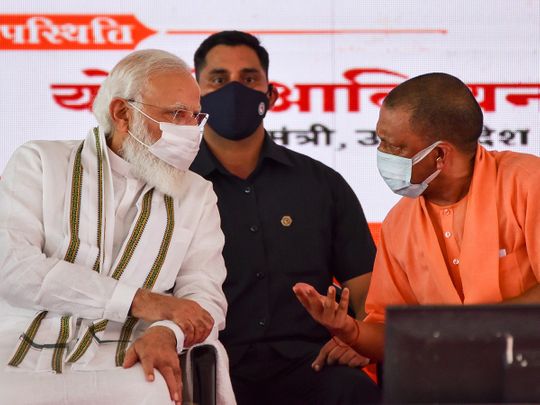
One old man sitting on a cot outside his shop in a village in Phulpur says he has no interest in elections.
How’s that possible? This is Uttar Pradesh, not south Mumbai.
“My wife went for panchayat election duty earlier this year. She was perfectly healthy. She returned with Covid and died. My brother and two cousins also died. After four deaths in the family, I have decided I’m not interested in elections.”
He is an exception. For most voters, the second wave of Covid is a non-issue. Not even those decisively voting against the ruling Bharatiya Janata Party blame the government for any negligence that lead to the devastating Covid second wave. The standard refrain you hear is that Covid was a pandemic, a “mahamaari”, that ravaged the entire world. Why blame Modi?
This shows once again that in the absence of an independent media, opposition parties have no channel of communication to voters. They are unable to explain to voters that it was government negligence that led to Covid second wave.
So if Covid is a non-issue, what are the issues for the people of Uttar Pradesh as it goes into an election?
Nishad Raj
At the Sangam, the meeting of three rivers, I ask Nishad boatmen who they think could win the election, due in February 2022.
I thought they might say Yogi Adityanath or Akhilesh Yadav or Mayawati or, who knows, even the Priyanka Gandhi-led Congress. Their unequivocal answer is “Dr Sanjay Nishad” of the “NISHAD” Party. This is a community whose traditional occupation revolves around the rivers.
The Nishad Party has been allied with the BJP but is bargaining hard in this election -- the unwritten threat of switching sides always looming large. Some might say caste leaders like him, known in UP as “chhutbhaiyya” or small-time leaders, just exploit caste for personal gains.
But Dr Sanjay Nishad’s demands for the welfare of his community are very specific: coaching centres for Nishad students, installation of a statue of a Nishad icon in a fort, change in reservation category of the community so it can get more government jobs and college seats. And, of course, a very large number of assembly seats to contest as part of the BJP alliance.
This explains why the boatmen of Sangam don’t really care whether it’s Yogi Adityanath or Akhilesh Yadav who wins. Their bread is buttered on the same side as their leader, Dr Sanjay Nishad. Since Dr Nishad is currently with the BJP, the Nishad community is happy to sing praises of the BJP.
They have suffered badly because illegal sand mining no longer takes place on the river beds. They made more as labourers stealing sand than as boatmen helping people bathe in the Sangam. But they trust Dr Sanjay Nishad with getting them the best possible deal.
Vote your caste
In other words, the main issue this UP election, as in every UP election, is caste. You won’t see this reflected in surveys, and these days even political scientists are desperate to claim the voter has moved beyond caste politics.
The BJP, the media and liberals will unite in telling you the main issue is Hindu nationalism. It isn’t. A BJP worker from the OBC Kushwaha community says Ram Mandir is a non-issue.
“It was an issue until other parties opposed it. Now everyone has accepted it,” he says, displaying an astute understanding of “polarisation” that seems to come naturally to every BJP worker.
Crime has a caste
I ask him what achievements of his government is he going to the people with? Free food grains during the Covid period, he says. Fine, that could save a family a few hundred rupees. What else? Better law and order, he says.
While the Uttar Pradesh police went on an ‘encounter’ spree to rein in the top criminals, crime statistics do not show much improvement. And yet, you can meet many voters who tell you that “Gunda Gardi” (petty crime) will increase should the Samajwadi Party come to power.
This “Gunda Gardi” is actually a code word for Yadav domination. Akhilesh Yadav’s attempts to change his party’s pro-criminal image haven’t worked much because the real issue is the domination of Yadavs in the village. The Samajwadi Party has not been able to deal with this perception issue — perhaps it can’t. Crime and punishment, like everything else, is about caste.
One of the BJP’s main campaign planks this election is to make people ‘remember’ what it was like, the unchecked crime and land grabbing of the Samajwadi era. This subtle anti-Yadav polarisation is the real polarisation; anti-Muslim consolidation comes second.
A new composite personality
Unlike Narendra Modi’s first term (2014-19), inflation has become a serious issue. Unemployment has worsened year upon year.
The extent to which a voter feels strongly about these issues seems to depend on their caste. It speaks once again of the opposition’s failure that they are unable to corner the BJP on their economic issues.
Yogi Adityanath is himself not very popular, owing to economic distress, caste issues and stray cows which damage crops.
BJP workers told voters in the general election in 2019 to think of Modi, not Yogi; to think of India, not their village. But now they have trained voters to think of a new composite personality — “ModiYogi” as if they are the same person. You ask someone who they’re voting for, and they’ll say ModiYogi.
The importance of being Anupriya Patel
The Samajwadi Party has done its own alliances with small caste parties, apart from inducting caste leaders. As reported last week in this column, it has had success with Pasi votes at least in the region in and around Allahabad.
Apart from the major alliance with the Jat-led Rashtriya Janata Dal, the SP has tied up with small caste parties led by Babu Singh Kushwaha, Sanjay Chauhan and Keshav Dev Maurya.
This may not be enough to exceed the BJP’s caste maths. The BJP in Uttar Pradesh stands on two legs. Those are not Modi and Yogi, as BJP workers might say. The two legs are Lodh and Kurmi. These two caste communities are so concentrated across districts that they give the BJP large chunks of seats. The tallest Lodh leader, Kalyan Singh, died recently. There is no big pan-UP Lodh leader now so the Lodh vote is well managed by the BJP.
Kurmi voters have their own party to back — the Anupriya Patel-led Apna Dal. She was a minister in the Modi government in the centre until the 2019 elections. After 2019, the BJP dropped her as it tried to create an in-house Kurmi leader in Swatantra Dev Singh.
But it didn’t work and the BJP recently made Anupriya Patel a minister again. How Kurmi voters feel about inflation or unemployment seems to swing up and down depending on how the BJP is treating Anupriya Patel these days.
I ask Kurmi voters praising Modi-Yogi if they’d still be voting for the BJP if Anupriya Patel was not with them. “We’ll have to think hard,” is how the typical reply goes.







